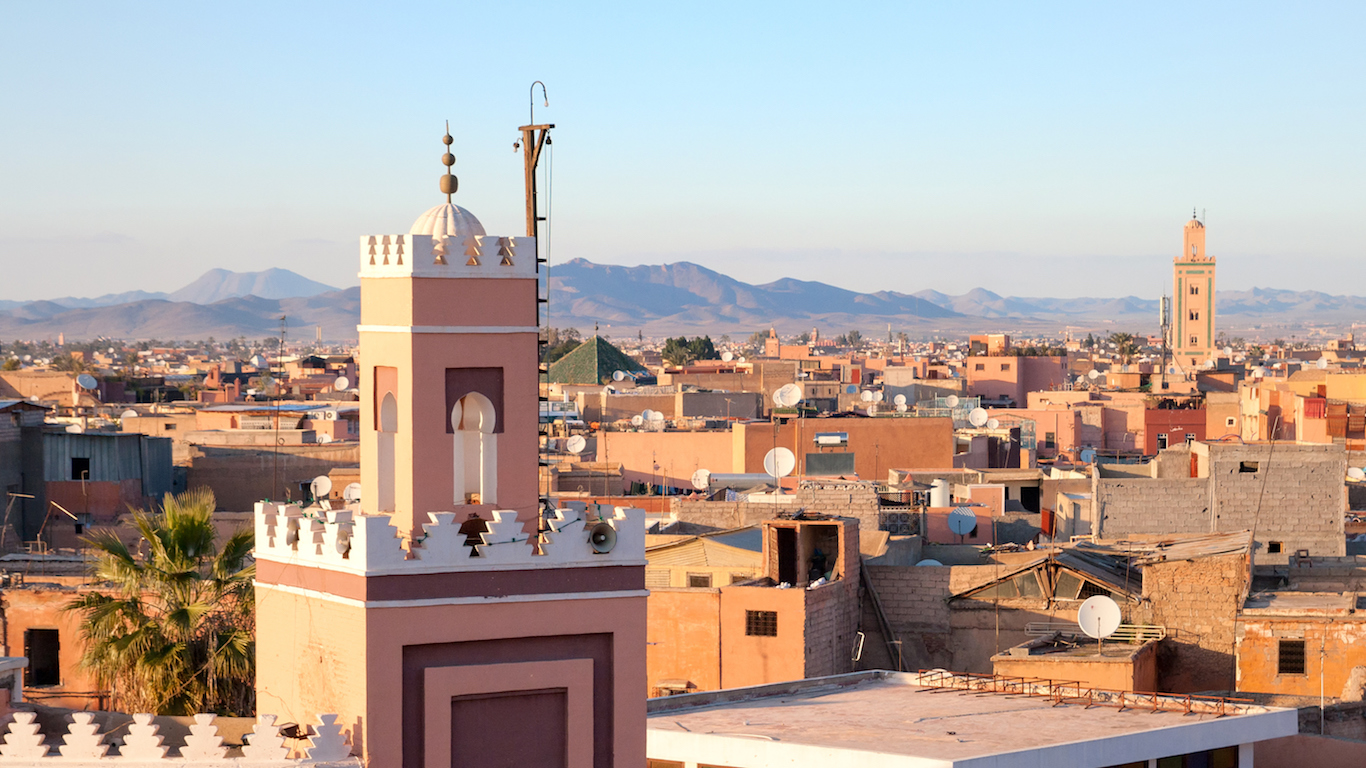US Goverment Sells Most of It’s Weapons To Nations! HMMMM
Countries Buying the Most Weapons From the US Government
The U.S. government sent nearly $10 billion worth of military vehicles and weapons systems to foreign governments last year. The United States is easily the largest exporter of arms in the world, surpassing other producers such as Russia and China by billions of dollars each year.
In the past five years, more than 100 nations have directly purchased aircraft, ships, armored vehicles, and missiles from the U.S. government. When excluding those nations that are not under international embargo, relatively few countries are left out of American arms deals. A few others, however, receive a disproportionately large share of American weapons. Thirteen countries accounted for almost 70% of U.S. 2016 arms exports. Saudi Arabia, a major U.S. partner in the Middle East, received almost 20% of total U.S. weapons exports.
24/7 Wall St. reviewed recently-released figures on state to state arms transfers from the Stockholm International Peace Research Institute’s Arms Transfers Database. These are the 13 Countries buying the most weapons from the U.S. government.
Click here to see the 13 countries buying the most weapons from the U.S. government.
Speaking to 24/7 Wall St., Aude Fleurant, director of SIPRI’s Arms and Military Expenditure Programme, explained the attitude the U.S. government has in regards to its arms exports. “The U.S. considers arms trade as a political strategic relationship. It is more willingly going to transfer weapons to countries in NATO, for instance, than it would to some other regions.” The United States deems a number of countries on this list, including the United Kingdom, Japan, Israel, and Australia, to be more trustworthy partners, and as such they are more likely to receive weapons.
As the world’s largest exporter, the United States also has the largest global weapons manufacturing industry. Of the five companies with the highest weapons and defense revenue, four are U.S.-based. When the U.S. government exports weapons to other countries, one of the many U.S. arms manufacturers — including such giants as Lockheed, General Dynamics, Raytheon, and Boeing — sells weapons to a program managed by the Department of Defense. Those weapons are then sold directly to other countries. Many of these arms sales are based on long-term partnerships and agreements, while other transfers are one-off orders.
The United States is one of the only countries in the world with a military large enough to support a private weapons industry on its own. Because starting up production for a major weapons system can be extremely expensive, nations that seek to maintain a domestic weapons manufacturing industry often rely on foreign trade partners. Rather than supporting local companies by selling their arms, Fleurant explained, many countries opt instead to rely almost entirely on imports.
Many of the nations that account for a high share of U.S. arms exports have demand for armaments, but have insufficient domestic arms production capabilities. These are countries like Saudi Arabia and Iraq, which have high military expenditure as a percent of GDP but few national arms manufacturers. “Countries that have national production capacity source weapons from domestic companies. That’s what the U.S. did during the wars in Afghanistan and Iraq,” Fleurant said. “But if you’re a country like Saudi Arabia, Qatar, or the United Arab Emirates, you don’t have national production capacity, or very little, so you’re going to turn to suppliers like the U.S.”
Most of the countries on this list import a large volume of weapons in general because they are either actively involved in military conflict or are in an unstable region where a strong military is regarded as a must. A large number of nations that import hundreds of millions of dollars in weapons from the U.S. can be found in the Middle East or in Northern Africa. “In the Middle East there’s a lot of conflict and tensions. You have the Yemen wars, the Syria war, you have domestic violence in Iraq and Afghanistan. In North Africa, almost all of these countries are dealing with insurgent groups, and there are fears of domestic unrest. All of these create conditions for the Middle East as an increasingly large recipient of weapons,” Fleurant said.
Several other major global arms importers are based in East Asia, where China’s growing and increasingly sophisticated military and its expansion into the South China Sea have put its neighbors on edge. As a result many of China’s neighbors have increased arms imports. South Korea, another major recipient of U.S. weapons, is on high military alert due to its relationship and proximity to its unpredictable neighbor, North Korea.
Mexico’s arms imports from the United States have more than tripled over the past decade as the government there continues to combat violent drug cartels.
To determine the countries buying the most weapons from the United States, 24/7 Wall St. reviewed annual arms transfer data from SIPRI for 2016. These 13 countries had the largest total arms imports for 2016. Additional data from SIPRI included total arms imports by nation as well as imports by specific type of armament. These data only include vehicles, missiles, and other major weapons systems, and exclude firearms. Additional data include military expenditure as a percent of GDP, from the World Bank, as well as GDP (PPP) from the International Monetary Fund.
These are the countries buying the most weapons from the U.S. government.\
13. United Kingdom
> 2016 arms imports from U.S.: $217 million
> 2016 total arms imports: $260 million
> U.S. as % total arms imports: 83.5%
> 2015 GDP: $2.7 trillion
About 84% of the U.K.’s total arms imports come from the United States. The remainder comes either from Israel or Germany. Over 75% of the country’s total arms imports between 2015 and 2016 were military aircraft. While it is not on par with the United States, Great Britain is one of the biggest arms dealers in the world in its own right, sending nearly $1.4 billion in weapons to other countries in 2016. One of the United States’ closest military partners, the U.K. was a key participant in the U.S. war in Iraq, committing about 46,000 troops at the height of the conflict. The U.K. also committed thousands of troops to the U.S. offensive in Afghanistan.

12. Egypt
> 2016 arms imports from U.S.: $238 million
> 2016 total arms imports: $1.5 billion
> U.S. as % total arms imports: 16.0%
> 2015 GDP: $1.1 trillion
Egypt has one of the largest armies in the world, with just under 500,000 active troops and several hundred thousand additional troops in reserve. The country went through major political upheaval in 2011, after long-time ruler Hosni Mubarak stepped down following a popular uprising. Perhaps because of the increased political tension, Egypt’s total arms imports over the five years through 2016 increased by about 70% from the previous five-year period, and imports from the United States increased by 46%. Over the last decade, the nation’s largest category of weapons imports were military aircraft. Egypt’s military arsenal also includes over 1,000 M1A1 Abrams tanks, a U.S. military staple manufactured by Virginia-based General Dynamics.

11. Morocco
> 2016 arms imports from U.S.: $244 million
> 2016 total arms imports: $254 million
> U.S. as % total arms imports: 96.1%
> 2015 GDP: $274 billion
More than 40 nations have larger economies than Morocco, but only 10 import more weapons from the United States. This is likely in part due to the fact that the North African nation spends over 3% of its GDP on its military, one of the higher shares in the world. The nation has a military of over 200,000 soldiers, a greater standing force than much larger nations such as Germany and the United Kingdom. Last year, Morocco imported roughly a quarter of a billion dollars worth of armaments, and the U.S. accounted for 96.1% of those weapons. The previous year, the United States was the sole supplier of weapons Morocco imported.


9. Japan
> 2016 arms imports from U.S.: $307 million
> 2016 total arms imports: $330 million
> U.S. as % total arms imports: 93.0%
> 2015 GDP: $4.8 trillion
A number of Southeast Asian nations have recently ramped up military expenditure and arms imports due to growing concern about China’s military development in the South China Sea. China has constructed a number of artificial islands, and is building on them what appear to be military bases with possible long-range surface-to-air missile capabilities. Another dispute between Japan and China over a group of islands in the East China Sea is causing additional tension. Despite the increased tension, Japan’s arms imports last year of $330 million were down from the previous year.
Over the last 10 years, Japan has imported over $4 billion in arms, 93% of which came from the United States. More than half the nation’s total weapons systems imports are in the form of military aircraft. Until 2015, the United States banned Japan from exporting weapons systems, a remnant of post-World War II policy. The long absence of a private arms industry in the country partially explains Japan’s current level of U.S. arms imports.

8. South Korea
> 2016 arms imports from U.S.: $501 million
> 2016 total arms imports: $1.3 billion
> U.S. as % total arms imports: 37.6%
> 2015 GDP: $1.9 trillion
South Korea is situated in an especially volatile and potentially dangerous part of the world. The country is separated from North Korea, its nuclear-armed, antagonistic neighbor to the north, by a demilitarized zone. South Korea has a policy of mandatory military service and has spent more on weapons systems in the past decade than all but a handful of other countries. Since 2007, South Korea has bought an estimated $10.7 billion in weapons from a range of countries, including France, Germany, Israel, and the United States.
Historically, the East Asian nation has imported most of its weapons from the United States. However, last year marked a departure from the trend. Only 37.6% of South Korea’s total arms imports came from the United States, nearly the smallest share in the last 10 years and well below the decade-high share of 95.2% in 2010. The majority of South Korea’s weapon imports last year came from Germany.

7. Italy
> 2016 arms imports from U.S.: $511 million
> 2016 total arms imports: $868 million
> U.S. as % total arms imports: 58.9%
> 2015 GDP: $2.2 trillion
Unlike many countries on this list, Italy has significant domestic weapons manufacturing capabilities. Leonardo, a Rome-based company formerly known as Finmeccanica, develops helicopters, fighter jets, and defense systems. The company sold $9.3 billion worth of arms in 2015 alone. Still, Italy imported hundreds of millions of dollars worth of military aircraft and sea vessels in 2016, in addition to about $23 million worth of missiles.
Italy’s weapons imports hit record highs in 2016. All told, the Mediterranean country bought $868 million in weapons from foreign governments in 2016, versus the next highest annual expenditure of $525 billion in 2007. The majority of weapons systems the country imported last year came from the United States.

6. Israel
> 2016 arms imports from U.S.: $526 million
> 2016 total arms imports: $607 million
> U.S. as % total arms imports: 86.7%
> 2015 GDP: $285 billion
A Middle Eastern country under near constant threat of terrorist attacks and armed conflict, Israel is one of only a few states with compulsory military service. In addition, the country spends about 5.4% of its GDP on defense, a larger share than all but a handful of other countries. American arms manufacturers are some of the biggest beneficiaries of Israeli defense spending. Israel bought some $526 million worth of arms and weapons systems from the U.S. in 2016 alone.
Israel is one of only a few countries on this list to have a significant domestic defense and weapons industry. The country is home to defense electronics company Elbit Systems, which reported $2.95 billion in arms sales in 2015, and to Israel Aerospace Industries, which reported $2.78 billion in 2015 arms sales. Each company ranks among the 35 largest companies in the world by arms revenue.

5. Qatar
> 2016 arms imports from U.S.: $595 million
> 2016 total arms imports: $901 million
> U.S. as % total arms imports: 66.0%
> 2015 GDP: $329.7 billion
The Middle East is one of the most dangerous and unstable regions in the world today. As a result, many MIddle Eastern countries without much of a defense industry of their own purchase weapons and defense systems from foreign countries. Qatar is one such country. The nation spent $901 million on weapons in 2016, the majority of which it bought from the U.S.
Qatar is an important strategic U.S. ally in the region. The Al Udeid Air Base, located just outside of the capital city of Doha, currently hosts some 10,000 U.S. troops, effectively making it the largest U.S. base in the Middle East.

4. UAE
> 2016 arms imports from U.S.: $773 million
> 2016 total arms imports: $1.3 billion
> U.S. as % total arms imports: 60.5%
> 2015 GDP: $644 billion
The United Arab Emirates is one of several Middle Eastern nations to rank among the U.S. government’s biggest weapons customers. The country bought some $773 million worth of weapons from the United States in 2016, more than from any other country. The UAE’s next largest weapons dealer was France, which sold the country some $336 million in weapons in 2016.
Missiles and air defense systems comprised the largest defense purchases the UAE made from foreign governments last year, at $554 million and $250 million respectively. Naval vessels were the country’s third largest arms import cost at $209 billion. The country has a substantial coastline along the Persian Gulf and the Gulf of Oman.

3. Australia
> 2016 arms imports from U.S.: $869 million
> 2016 total arms imports: $1.1 billion
> U.S. as % total arms imports: 82.0%
> 2015 GDP: $1.1 trillion
Australia bought more weapons from the United States last year than any other country outside of the Middle East. The vast majority of Australia’s 2016 arms imports were aircraft and missiles. The United States supplied over 80% of these weapons systems, accounting for $869 million of the country’s total weapons imports. Meanwhile, Italy and France each sold Australia $80 million worth of weapons, and Germany accounted for an additional $32 million of the country’s military spending.
Australia is home to one of the world’s 100 largest defense contractors by revenue. Austel, a shipbuilding company, reported $980 million in arms revenue alone in 2015.

2. Iraq
> 2016 arms imports from U.S.: $893 million
> 2016 total arms imports: $1.7 billion
> U.S. as % total arms imports: 51.5%
> 2015 GDP: $534 billion
The militaries of few countries are as dependent on the U.S. government as Iraq’s. Since U.S. troops toppled the Iraqi government in 2003, the country has been in a near-perpetual state of disorder. Currently, the Iraqi military, under the guidance of U.S. advisors, is fighting to free parts of northern Iraq from Islamic State control. A major battle is currently underway for the city of Mosul.
Iraq is a major buyer of American weapons. The country imported $893 million worth of U.S. weapons and defense systems in 2016, the second highest sum of any country in the world. Iraqi weapon imports do not come close to the total amount spent by the U.S. in Iraq in recent years. Some estimates put total DoD and State Department spending in Iraq since 2001 at over $800 billion.

 24/7 Wall St.
24/7 Wall St.





